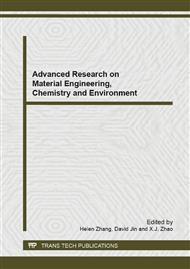p.89
p.95
p.100
p.105
p.110
p.114
p.119
p.127
p.132
Effect of TiO2 Nanoparticles on Cellulose Acetate Microporous Membrane Performance
Abstract:
The hydrophilic and mechanical strength of the cellulose acetate microporous membrane (CAMM) were improved by dealt with TiO2 nanoparticles, which were obtained by adding a super dispersant into TiO2-aqueous dispersion. The influence of such factors as temperature, processing time and TiO2 concentration on adsorption amount of CAMM were investigated. The experiment data indicated that water flux of the modified CAMM increased with the increase of the TiO2 adsorption amount. It suggested that hydrophilic of the CAMM was improved than that of blank. Experiments data also showed that the modified CAMM was better in mechanical strength but was weaker in elastic deformation than those of the blank. Water flux stability of the modified CAMM has improved significantly. Better modified conditions are as follows:TiO2 concentration 0.1mol·L-1,temperature 35°C, processing time 6h, and adsorption amount 9.708mg/g.
Info:
Periodical:
Pages:
110-113
Citation:
Online since:
September 2013
Authors:
Price:
Сopyright:
© 2013 Trans Tech Publications Ltd. All Rights Reserved
Share:
Citation:


